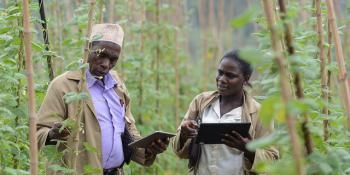Ninigui: A war against… erosion and desertification. - Part I: The problem
A village in Northern Burkina Faso fights the odds, and turns the tide
In the north of Burkina Faso, about one hour’s drive from Ouahigouya, the trees change into low scrubby bushes, the grass turns yellow, and as we drive on, it eventually disappears. The dirt track dissolves into a rocky river bedding, climbs up a steep ridge and levels on a plateau. We stop for second, and take in the scenery.
The landscape is barren. The soil is a dark brown crusted gravel, often bereaved of any vegetation. Houses are grouped together, with the mosques and low mud grain stores sticking out. Here and there a group of kids walks to the school at the edge of the village. A large troop of cows, herded by two nomads, kicks up a cloud of dust.
Ninigui feels like a border town. A village on the edge of the desert and on the edge of survival.

Ganame Adama, who heads NAAM, the local farmers’ union, takes us to his field where he just harvested his millet crop. “Look around you”, he says, “All of this used to be forest. At the time of my father’s father, they hunted wild animals here. They grew a crop without using any fertilizer. They had crops every year without much effort.”
As the forest was cut for firewood, gradually the rains carried away the thin top soil. To make matters worse, the rainy season shifted: it started later, lasted shorter, and came in repeated violent squalls, often causing flooding as the barren ground was no longer able to absorb the rain. “Rains just gushed over the ground”, Adama explains, “In the hills, it dug out ravines, emptying into the flats. The water would just carry away whatever we had sown. It was no use to apply fertilizer neither. Each time it rained, everything was carried away.”
The men migrated to the neighbouring countries, looking for work. “In the village, you could only find women, babies and old people”, whispers Helene Nana, one of the leading women in the village. “People sometimes talk about misery and poverty, but we, we lived through it. We know what hunger means. We could hardly produce anything anymore on our fields. Children died because of malnutrition. We were so poor we had no money to pay for their funeral. THAT is poverty, THAT is what we lived through.”

Helene turns away, and looks over the horizon. “We had to change. The weather had changed, and we had to change with it. Once we realized that, now twenty years ago, things turned around for us.”
“There were very few of us left in the village”, explains Ganame Ousseni, who keeps cattle. He scrapes his foot over the crusted soil as if to emphasize how hard things were. “We organised ourselves into a farmers’ union and applied for funds to make a small dam. Nobody approved the credit. Nobody believed in a future here. So we rolled up our sleeves and built a mud dam ourselves. The whole village helped. The first year, the dam turned the lowlands into a huge water hole. Even though eventually the mud gave away and the dam broke, we had proven a point: the water would stay. So the next year, we got the credit, and build a proper dam.”

“And that changed everything. The dam could hold the water through almost the whole dry season. The cattle could come and drink from it, and we started to grow vegetables around it, irrigating the crops with water from the dam. Yes, from there on, it only got better. It gave people hope. The war was not won, but we surely had won a battle”, Helene smiles, “we had proven to ourselves we could fight back against the odds, against the weather, the desertification, the erosion, and against poverty. That insight changed everything”.
Read about Ninigui's fight against climate change in more detail: how Adama grows his crops in the desert, how Helene started vegetable farming, and Ousseni compliments his farming with cattle herding.
The way ahead for researchers and smallholder farmers facing current and coming challenges posed by climate change lies in learning from each other while sharing knowledge and experiences.
Photos in this article by Peter Casier.


